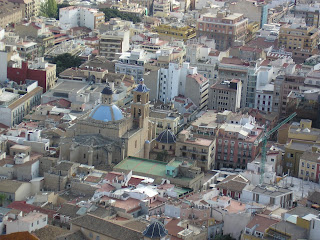Alicante: Castillo de Santa Barbara and Barrio de Santa Cruz
exploring the layers of history with Turiguias
Alicante has been a major port for thousands of years with layer upon layer of history. The city’s warm, fertile climate and strategic position in the Mediterranean basin (relatively close to Africa) ensured the city’s historic importance.
Mount Benacantil dominates the city’s skyline and is topped by the Castle of Santa Barbara. I learned a great deal about the city’s history from Maria Jose Aparicio, the owner of Turiguias, who gave me a personal tour of the Castle and the old fishermen’s quarter of Santa Cruz.
Maria Jose, Mireia Aldeguer (Mandarinablue Travel Experience) and I started our tour in the town centre. Maria Jose had a wealth of information that added depth to my understanding of the city. For example, the waterfront used to be much further in, but they gradually extended the land surface by dumping waste at the water’s edge.
Castillo de Santa Barbara
A very modern tunnel and elevator provides quick and easy access to the Castle of Santa Barbara. The Roman settlement was located on the plain, slightly behind another hill. It was the Arabs and later the Castilian Christians who built a fortified castle on top of the rock outcropping overlooking the harbour.
The views from the top of the castle are fantastic with an extensive view of the harbour in all directions, which must have provided an invaluable early warning system for maritime invasions.
Maria Jose recounted a tragic story of forbidden love between an Arab princess and her suitor, who both threw themselves off the cliff when the king ordered his daughter to marry another man. You can make out the king’s profile in the face of the rock as he weeps over the loss of his daughter.
Castle Walls
We made our way down from the Castle by following the old fortifications. There are various routes that you can take as well as outlooks and small parks and even a fancy restaurant.
It’s great fun to look down on the church domes and the mishmash of old and modern buildings in Alicante. I was delighted to see someone practising tai chi in a park, and Maria Jose said that many people use this park for tai chi or yoga.
The Santa Cruz neighbourhood is a tangled maze of narrow streets and white stucco houses. The fishermen built their neighbourhood between the castle walls, so it’s very compact – and picturesque. There are lots of stairs from one level to another, and I was amused to learn that the city has just installed a wooden ramp to make it easier for people to pull their grocery carts (bags on wheels) up the hill.
It was a warm evening, and there were lots of children playing in the street and groups of neighbours chatting. There are several local bars where you can enjoy a drink.
Turiguias
When I’m travelling, I try to learn something of the history and culture of the places I visit, usually by reading books and internet sites. But it’s so easy to misunderstand or to miss the quirky anecdotes that bring the place to life.
Maria Jose is a knowledgeable advocate for her city, and I would highly recommend her tours, which are both informative and interesting.
Her company, Turiguias, offers group tours for cruise ships, conventions and other large groups. She also offers small group tours in both English and Spanish for anyone who is interested every Saturday (check the website for schedule changes on holiday weekends).
Maria Jose (left) with Mireia (right)
See Also:
Mandarinablue Travel Experience
Shopping in Alicante
Chocolate and Pirates











Comments